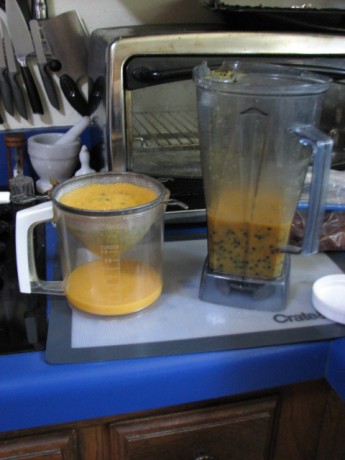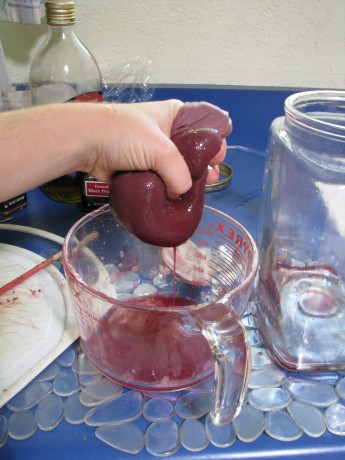Fruit
- Fruit, Gardening adventures, Permaculture and Edible Forest Gardening Adventures, Recipes, Seeds, Vegan, Vegetarian
Jackfruit: The Largest Fruit in the World
 I’d heard a lot about vegetarians using unripe jackfruit in the place of pulled pork because it can have the same texture. I had looked for canned jackfruit to no avail until a friend on Facebook (that most reliable of news sources) wrote that they had seen fresh jackfruit at 88 Ranch market in Temecula, a neighboring town.
I’d heard a lot about vegetarians using unripe jackfruit in the place of pulled pork because it can have the same texture. I had looked for canned jackfruit to no avail until a friend on Facebook (that most reliable of news sources) wrote that they had seen fresh jackfruit at 88 Ranch market in Temecula, a neighboring town.Off Miranda and I went. Not only did we find amazing and wonderful produce and mushrooms there, but we found the jackfruit.
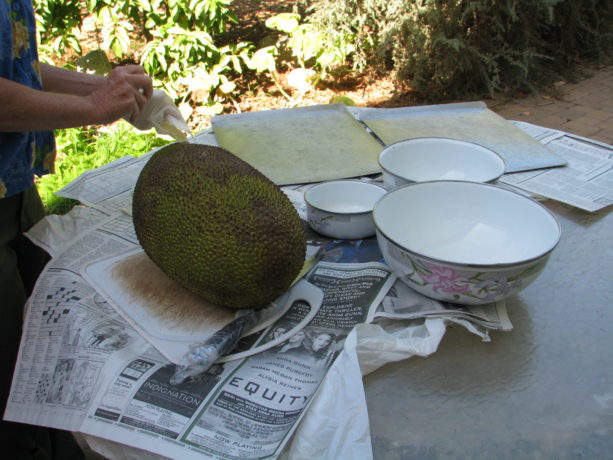 Jackfruit are the largest fruit in the world and are produced on the largest fruit-bearing tree in the world. The fruit can weigh 80 or more pounds. The more manageable one we purchased was a mere fifteen pounds.
Jackfruit are the largest fruit in the world and are produced on the largest fruit-bearing tree in the world. The fruit can weigh 80 or more pounds. The more manageable one we purchased was a mere fifteen pounds.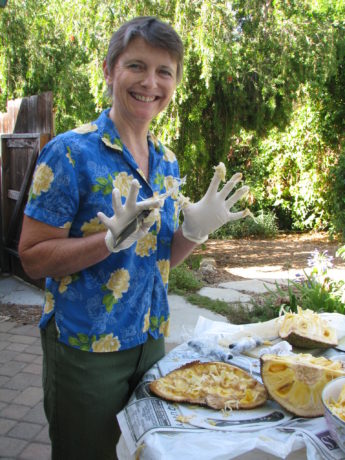 Jackfruit has latex in its core and stem, so butchering one (does one simply slice something that large?) requires some planning. We did it outside.
Jackfruit has latex in its core and stem, so butchering one (does one simply slice something that large?) requires some planning. We did it outside.  Following Internet advice (which is always true and sound) (at least in this case it was) we spread out plastic with newspaper on top, covered our knife handles with plastic wrap, and used nitrile gloves. What I forgot to do was coat the knife blades with oil, but it all worked out okay.
Following Internet advice (which is always true and sound) (at least in this case it was) we spread out plastic with newspaper on top, covered our knife handles with plastic wrap, and used nitrile gloves. What I forgot to do was coat the knife blades with oil, but it all worked out okay.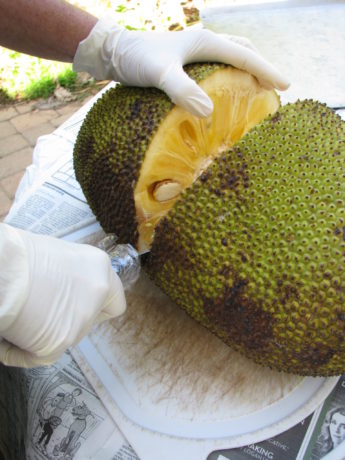 Indeed, the inside was amazing. The core in the center of the fruit did weep white latex which we wiped away. This fruit was ripe, although the bumpy outside had been green.
Indeed, the inside was amazing. The core in the center of the fruit did weep white latex which we wiped away. This fruit was ripe, although the bumpy outside had been green.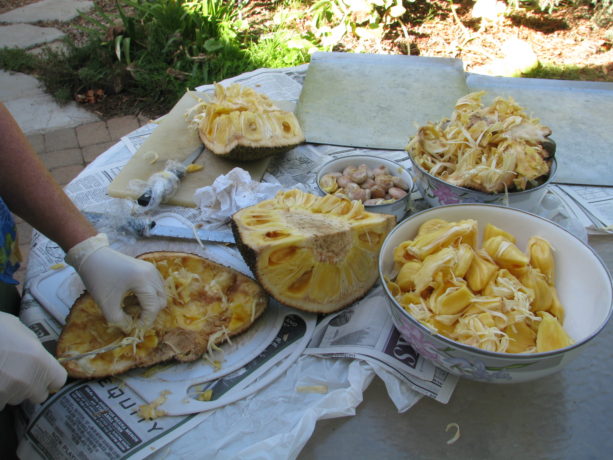 The scent was tropical and enticing. The fruit is actually the fleshy sections that surround the large seeds. This we tore out with our fingers.
The scent was tropical and enticing. The fruit is actually the fleshy sections that surround the large seeds. This we tore out with our fingers. 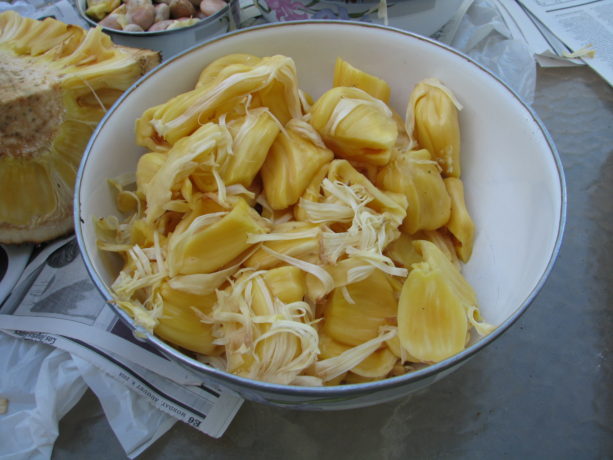 It was firm and yet soft, not mushy, and a light apricot color. The seeds are edible too.
It was firm and yet soft, not mushy, and a light apricot color. The seeds are edible too. 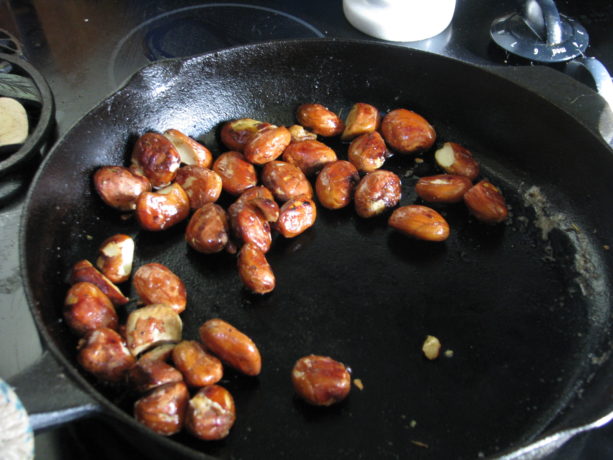 We boiled a batch, then had to slip off their protective coating then pan-roasted them, and they tasted like baked potatoes with the skin still on.
We boiled a batch, then had to slip off their protective coating then pan-roasted them, and they tasted like baked potatoes with the skin still on. 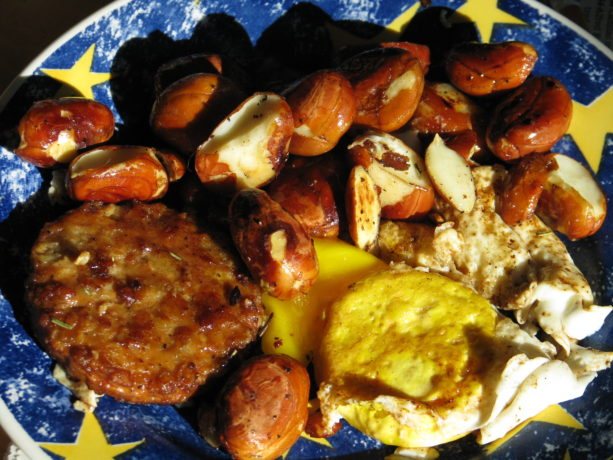 We roasted more in the oven and they didn’t taste so great, but I think that was my fault not theirs.
We roasted more in the oven and they didn’t taste so great, but I think that was my fault not theirs.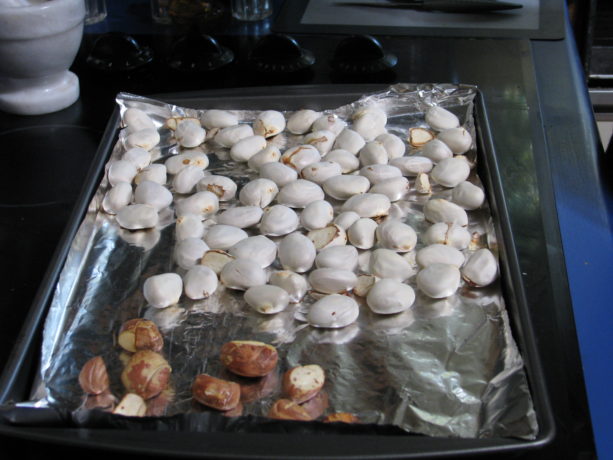 I planted several, and one sprouted and is now in the greenhouse about two inches tall and wondering how far he fell from the tree.
I planted several, and one sprouted and is now in the greenhouse about two inches tall and wondering how far he fell from the tree. The ripe fruit has a flavor that is both mango and pineapple. It is SO GOOD. As it wasn’t goopy or full of juice, the fruit was easy to deal with. We lay most of it on cookie sheets, froze them and them put them in freezer bags. The frozen pieces taste like mango popsicles, and the fruit thaws without much change in texture; I brought some along for snacks on a trip.
The ripe fruit has a flavor that is both mango and pineapple. It is SO GOOD. As it wasn’t goopy or full of juice, the fruit was easy to deal with. We lay most of it on cookie sheets, froze them and them put them in freezer bags. The frozen pieces taste like mango popsicles, and the fruit thaws without much change in texture; I brought some along for snacks on a trip. 
The part that is used for pulled pork is the fleshy parts that weren’t pollinated and didn’t develop a seed. They can be cut out and marinated. As this fruit had ripened, these parts had a bit of a fruity flavor to them, but we used it anyway.
Clean up wasn’t as bad as we had thought. Throughout the process we had to switch gloves because the latex would make the fruit stick to them. The knife blades cleaned up after soaking in boiling hot water.
We also bought the canned fresh and unripe fruit, but haven’t tried them yet.
Jackfruit is mostly grown in Asia, but also has popped up in South America and even Southern California and Florida.
When jackfruit come back to the store, and the weather is warm, it will be a fine day for another butchering. Or I can wait for a decade for my little jackfruit sprout to grow up and shade out part of the Finch Frolic food forest and produce monster fruit. Until then we have really superb jackfruit pieces frozen on which to nibble.
- Arts and Crafts, Breads, Cake, Condiments, Dessert, Fruit, Gardening adventures, Herbs, Vegan, Vegetables, Vegetarian
2016 Marketplace and Last Tours of the Year
Our Marketplace is extended to Sunday, Nov. 20th, 9 – 2!
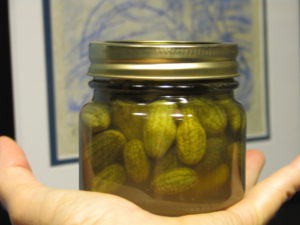 At Finch Frolic we’ve come to celebrate the end of our season with a Marketplace. This year our Marketplace will happen one day only, this Sat. Nov. 19th from 8-3. Finch Frolic is located at 390 Vista del Indio, Fallbrook, CA. We’ll be selling our abundance. Here’s some of the goodies you’ll find:
At Finch Frolic we’ve come to celebrate the end of our season with a Marketplace. This year our Marketplace will happen one day only, this Sat. Nov. 19th from 8-3. Finch Frolic is located at 390 Vista del Indio, Fallbrook, CA. We’ll be selling our abundance. Here’s some of the goodies you’ll find:Tiny Cocktail Mouse Melons (cucumbers… so cute!)
Amazing, milk-free Passionfruit Curd
Incredible tropical Guava Jam
Pickled Garlic
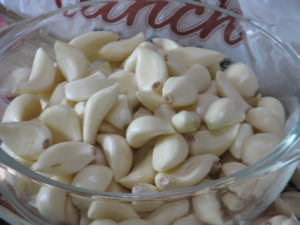
Whiskey Cranberry Relish
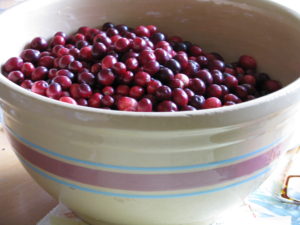
Nectarine Amaretto Jam
Tangy Plum Jam
Our very best dill Pickles

Jelly Palm Jelly
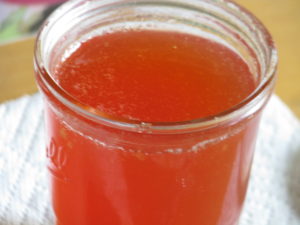
Spicy Jalapeno Carrots
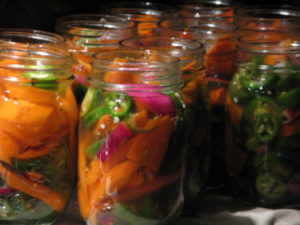
Hand-grated, homegrown organic Horseradish Sauce
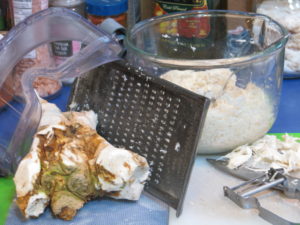
Guava Halves in Simple Syrup
Guava Paste squares – eat as is or put them in baked goods, or pair with slices of cheese. Ummm!
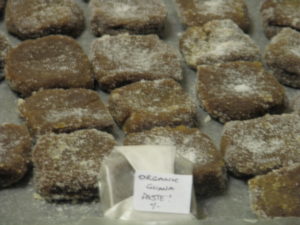
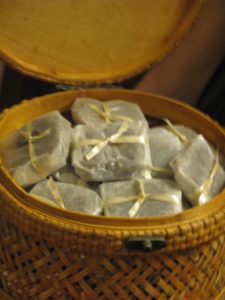
Frozen Passionfruit Juice cubes
Our famous Pomegranate Gelato
Frozen Pomegranate Arils, all ready to sprinkle on your baked goods or mix in a salad or stuffing.
Clear, amazing Guava Jelly
Frozen Plum, Guava and Peach slices
Frozen strained cooked organic home-grown pumpkin, all ready for a pie or bread!
Our best-selling Cranberry Biscotti
Gingerbread Houses. Pair them with our Passionfruit Curd for a memorable dessert!
Lilikoi (Passionfruit) Poundcakes. Small amazing tropical bundles of yum.
Guava Sauce, like applesauce but guava. Very low sugar!
Fresh Jerusalem Artichoke (Sunchoke) roots. Cook them or plant them!
Layered Curry Mix – a sensual trip to the Middle East, either layered in cute little jars for a gift or in bags for use at home. Make a curry with these organic spices!
Lime Juice Cubes
Candied Orange Peels. From our organic oranges. A much better stocking stuffer than hard candy. Or top your baked goods with a twist.
Fresh, fragrant guavas, both white and pink

Fresh kiwanos, those thorny African fruit that sell for a fortune at the stores.
And more!
Plus, we’ll be selling some knick-knacks, and a few garage sale items . A punching bag anyone?
PLUS, we’ll have a selection of native plants lovingly grown locally.
And we’ll have amazing succulents from our neighbor Rosa of Roja’s Succulents. You’ll pass by her business on the way in, so please stop by on the way out and see her incredible inventory of plants, all organically hand-grown by Rosa. I never loved succulents until I saw her collection, and her very low prices!
Except for the gelato, we’re dairy (milk) free this year. We use organic eggs from cage-free hens, and otherwise use vegan butter that I make at home which is coconut-oil and rice milk based.
Our last two tours of the year (the garden closes from Thanksgiving until March 1. We will still be available for consultations and appearances) will be this weekend, Nov. 19th and 20th, both at 10. [UPDATE: THE SATURDAY TOUR IS FULL. THERE IS STILL ROOM FOR THE SUNDAY TOUR]. The tours are our usual 2-hour concentrated Intro to Permaculture walks through the garden. The tours cost $15/adult and you will come away with so many ideas and so much information that you’ll spend the next week working in your garden! Please RSVP for the tours to dianeckennedy@prodigy.net.
Your continued support helps Miranda and I keep our consultation and tour prices low, and enables us to keep teaching and spreading the word on permaculture. So thank you!
-
Adventures with Fruit: Pindo (Jelly) Palms
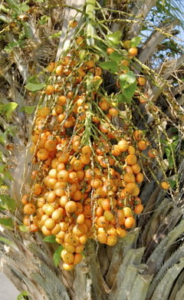 Evaluating the usefulness of the plants in your yard is a big part of permaculture; once you understand what each plant does, you will know if it is useful either to you, to wildlife or to the environment, or if it is causing harm. There are many food-producing plants that we think of as weeds or as ornamentals. Always, always, always be sure before you pop something in your mouth. So by identifying your plants you can add to your diet, and if something is already successfully growing in your yard and you can use it, fantastic!
Evaluating the usefulness of the plants in your yard is a big part of permaculture; once you understand what each plant does, you will know if it is useful either to you, to wildlife or to the environment, or if it is causing harm. There are many food-producing plants that we think of as weeds or as ornamentals. Always, always, always be sure before you pop something in your mouth. So by identifying your plants you can add to your diet, and if something is already successfully growing in your yard and you can use it, fantastic!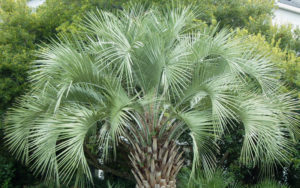 You’ve probably walked past them, or even looked askance at the dropped fruit without realizing. Also called Jelly Palms, the pindo palm is a common landscape tree for drought-tolerant hot areas. The fronds look very pokey, but are rather soft. That is a relief because once you’ve tasted the ripe fruit you’ll be thrashing through the fronds trying to pick more of them.
You’ve probably walked past them, or even looked askance at the dropped fruit without realizing. Also called Jelly Palms, the pindo palm is a common landscape tree for drought-tolerant hot areas. The fronds look very pokey, but are rather soft. That is a relief because once you’ve tasted the ripe fruit you’ll be thrashing through the fronds trying to pick more of them.Pindo palms (Butia capitata) are called Jelly Palms because the fruit has a lot of pectin in them. The trees are also called Wine Palms because you can make a cloudy wine from the fruit. But then, mankind has proven that you can make alcoholic beverages from just about anything.
The fruit is small and fiberous with a big seed, and falls to the ground when very ripe. They taste amazing. The burst of flavor is as if a pineapple and an apricot had a little yellowish baby. The best way to eat them is to gently chew the whole thing and swallow the juice, then spit out the fiber and seed.
We have two jelly palms at Finch Frolic Garden, only because they didn’t have identification we didn’t really know what they were. At the beginning of this year Miranda and I were evaluating the garden plants using the Three Positives rule (where everything in the garden has to give you three positive things. If it doesn’t, then it should be turned into hugelkultur or mulch). Several trees were repurposed and we were eyeing the palms. These palms are squat and short, not slim and tall like the very similar Queen palms. Fortunately for them, and as it turned out, for us, the trunks were too thick for my small chainsaw so we didn’t remove them with the others. This threat seemed to work because they set fruit on long stalks. We hesitantly tried one… and then just about ran each other over trying to get more!
Queen palms also produce an edible fruit that is sweeter, but is only edible when very ripe.
The fallen ripe fruit can attract bees and wasps because, well, everyone wants some. We waited until the stalks were just about completely ripe then cut them off and left them in a paper bag. The fruit then ripened and dropped off in the house where we could have them all.
Most of what I know about the Pindo Palm comes from the website Eat the Weeds by Greene Deane.
We cleaned them and froze them. Now we’re making Pindo Palm Jelly. Or maybe Jelly Palm Jelly, which sounds better.
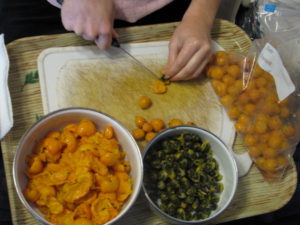 Freezing and thawing the fruit actually helps break down some of the fiber and release juices, and makes them much easier to pit. The pits are high in oil, so advice for cooking the fruit whole says the jelly can pick up bitter flavor from the seeds. We sat with trays laden with cutting boards, a knife and bowls and pitted them. Yes, this is how we spend our evenings when I’m not out dancing, processing fruit and watching a movie or reruns of the Bob Newhart show or something. Yep.
Freezing and thawing the fruit actually helps break down some of the fiber and release juices, and makes them much easier to pit. The pits are high in oil, so advice for cooking the fruit whole says the jelly can pick up bitter flavor from the seeds. We sat with trays laden with cutting boards, a knife and bowls and pitted them. Yes, this is how we spend our evenings when I’m not out dancing, processing fruit and watching a movie or reruns of the Bob Newhart show or something. Yep.The thawed fruit was easy to push away from the seed, so the process went very quickly although our fingers were pretty cold from the fruit.
We covered the pitted fruit with water and cooked it for about an hour, then strained out the fruit. There isn’t a lot of pulp because of all the fiber.
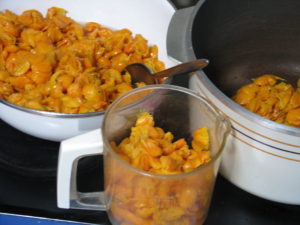 We used the National Center for Home Food Preservation’s recipe which used a lot of sugar, but the juice is so tart that it needed it.
We used the National Center for Home Food Preservation’s recipe which used a lot of sugar, but the juice is so tart that it needed it.What we got was a beautiful jelly that,despite the natural and added pectin was fairly loose. The benefit was that it can be used as a syrup as well. While the flavor of the jelly isn’t quite as astonishing as the fresh fruit, the tart tropical flavor is very good.
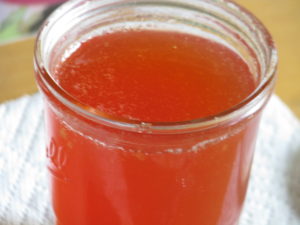
So walk around your weeds and trees and identify them, read up on them, and perhaps you can find a treasure in your yard as we have!
(We’ll be selling Jelly Palm Jelly at our annual Marketplace here at Finch Frolic Garden on Sat. Nov. 19th, 2016)
- Dessert, Fruit, Gardening adventures, Herbs, Special Events, Spices, Vegan, Vegetables, Vegetarian, Water Saving
Our Annual Marketplace, and Last Tours of 2015
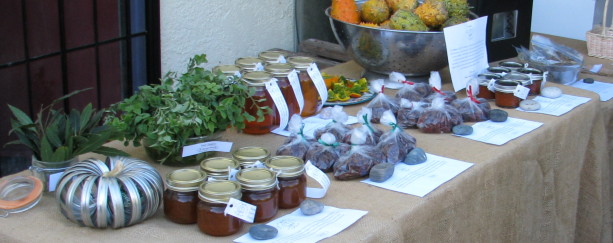 Our fourth-annual Finch Frolic Marketplace will take place Nov. 21 and 22nd from 9 – 2. We’ve been working like little permaculture elves, harvesting, preparing fruit and vegetables, canning, baking, and inventing new recipes for your table and for gifts. We have a curry spice mixture that is amazing. Our record white guava harvest has allowed us to create sweet guava paste and incredible guava syrup. We’ve pickled our garlic cloves, as well as zucchino rampicante, and our Yucatan Pickled Onions have a wonderful orange and oregano base that is fabulous. Of course there is Miranda’s small-batch Pomegranate Gelato, Whiskey-Baked Cranberry Relish, and a selection of curds (passionfruit, lemon-lime, and cranberry). So much more, too. We’ll also be selling plants from several sources, and some collectibles and knick-knacks from my home. Please come support a small business early – a whole week before Small Business Saturday! Your patronage allows us to continue teaching permaculture.
Our fourth-annual Finch Frolic Marketplace will take place Nov. 21 and 22nd from 9 – 2. We’ve been working like little permaculture elves, harvesting, preparing fruit and vegetables, canning, baking, and inventing new recipes for your table and for gifts. We have a curry spice mixture that is amazing. Our record white guava harvest has allowed us to create sweet guava paste and incredible guava syrup. We’ve pickled our garlic cloves, as well as zucchino rampicante, and our Yucatan Pickled Onions have a wonderful orange and oregano base that is fabulous. Of course there is Miranda’s small-batch Pomegranate Gelato, Whiskey-Baked Cranberry Relish, and a selection of curds (passionfruit, lemon-lime, and cranberry). So much more, too. We’ll also be selling plants from several sources, and some collectibles and knick-knacks from my home. Please come support a small business early – a whole week before Small Business Saturday! Your patronage allows us to continue teaching permaculture.
Join us for a tour! Our last two Open Tours will also be held that weekend, each at 10 am. The tours last about two hours and we should be having terrific weather for you to enjoy learning basic permaculture as we stroll through the food forest. Please RSVP for the tours to dianeckennedy@prodigy.net. More about the tours can be found under the ‘tours’ page on this blog.
Finch Frolic Garden will be closing for the winter, from Thanksgiving through March 1. However, Miranda and I will still be available for consultations, designs, lectures and workshops, and we will be adding posts to Vegetariat and Finch Frolic Facebook (you don’t need to be a member of Facebook to view our page!).
Have a very safe and very happy holiday season. Care for your soil as you would your good friends and close family, with swales, sheet mulch and compost, and it will care for you for years.
Diane and Miranda
- Arts and Crafts, Books, Breads, Cake, Dessert, Fruit, Giving, Herbs, Perennial vegetables, Permaculture and Edible Forest Gardening Adventures, Recipes, Sauces, Seeds, Special Events, Spices, Vegan, Vegetables
Finch Frolic Marketplace, Revisited
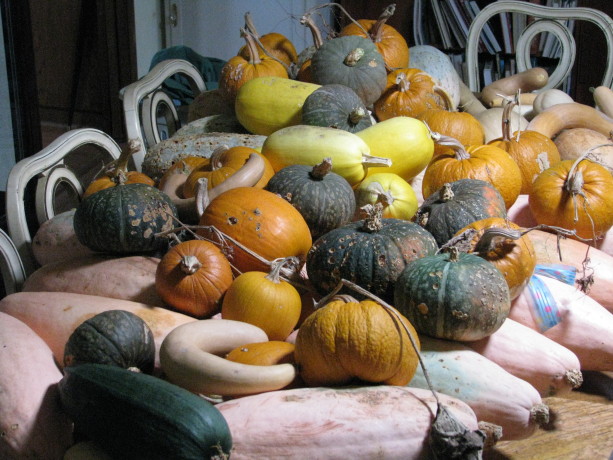
Wonderful, tasty winter squash of all kinds! Due to popular demand, we’re having one more short Marketplace this Saturday, 9 – 1.
Join us on Saturday, November 29nd from 9-1 for the annual Finch Frolic Marketplace, the Extended Version! We’ll have for sale fresh and prepared foods straight from our permaculture gardens. All are excellent gifts, or will grace your holiday table. We’ll have the much-desired Pomegranate Gelato again, and new this year, Passionfruit Gelato! Squash, fruit, veg, preserves, passionfruit curd, baked goods, and much more.
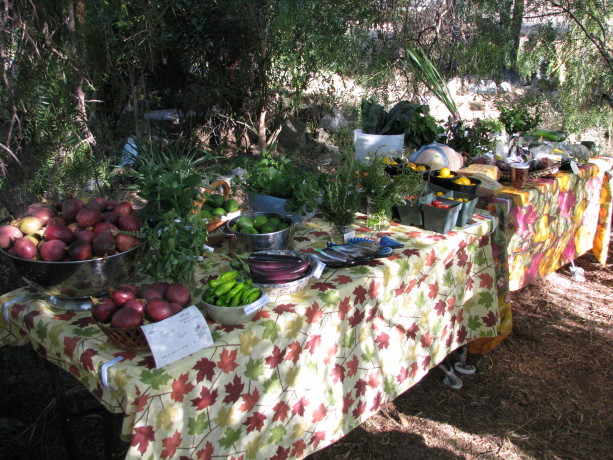
Herbs, veggies, frozen juice, gelatos, curds, jams, preserves… and much more! Finch Frolic Garden is located at 390 Vista del Indio, Fallbrook, CA.
Directions:
Finch Frolic Garden is open by appointment only for tours, lectures and other activities. The address is 390 Vista del Indio, Fallbrook, CA 92028-2548. Please call only if you are lost or delayed; we use our house phone only and are often not inside. Please use the email above for any other communication.
From the North (Temecula and above): take 1-15 South to Exit 51 and turn right. Make the next right onto E. Mission Rd/County Hwy-S13. In .8 of a mile turn left onto E. Live Oak Park Rd. In 1.6 miles turn right onto Alvarado St. In .7 miles at the top of the hill turn left onto Vista Del Indio, at Roja’s Succulents. Make the very first right; 390 is at the end to the left.
From the South (Escondido and below): take I-15 North to Exit 51 and turn left over the freeway. Make the next right onto E. Mission Rd/County Hwy-S13. In .8 of a mile turn left onto E. Live Oak Park Rd. In 1.6 miles turn right onto Alvarado St. In .7 miles at the top of the hill turn left onto Vista Del Indio, at Roja’s Succulents. Make the very first right; 390 is at the end to the left.
From the West (I-5): take CA-76 East, Exit 54A and drive for 12.6 miles. Turn left onto S. Mission Road/County Hwy S13 for 4.1 miles. Turn right onto S. Stagecoach Lane (at the high school). In 2.8 miles turn right onto Alvarado St. At the top of the hill turn right onto Vista del Indio, at the Roja’s Succulents sign. Make the very first right; 390 is at the end on the left.
- Animals, Bees, Birding, Compost, Fruit, Fungus and Mushrooms, Gardening adventures, Herbs, Hugelkultur, Natives, Other Insects, Permaculture and Edible Forest Gardening Adventures, Ponds, Predators, Rain Catching, Reptiles and Amphibians, Seeds, Soil, Vegetables, Water Saving, Worms
The Mulberry Guild
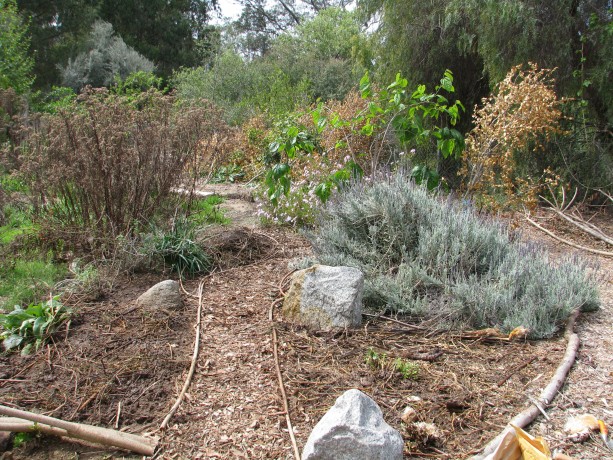
The renovated and planted mulberry guild. One of our larger guilds has a Pakistani mulberry tree that I’d planted last spring, and around it had grown tomatoes, melons, eggplant, herbs, Swiss chard, artichokes and garlic chives.
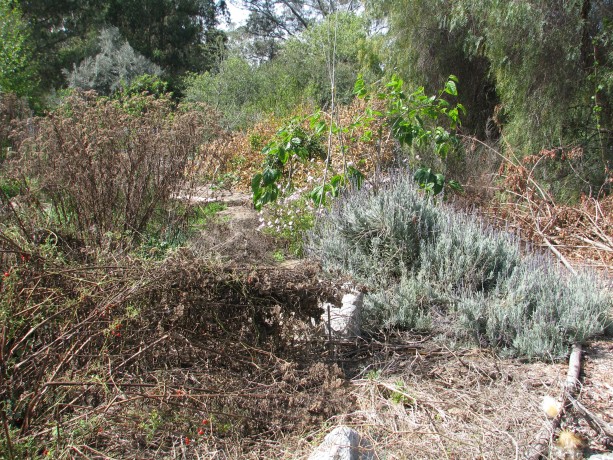
Mulberry guild with last year’s plant matter and unreachable beds. This guild was too large; any vegetable bed should be able to be reached from a pathway without having to step into the bed. Stepping on your garden soil crushes fungus and microbes, and compacts (deoxygenates) the soil. So of course when I told my daughter last week that we had to plant that guild that day, what I ended up meaning was, we were going to do a lot of digging in the heat and maybe plant the next day. Most of my projects are like this.
Lavender, valerian, lemon balm, horehound, comfrey and clumping garlic chives were still thriving in the bed. Marsh fleabane, a native, had seeded itself all around the bed and had not only protected veggies from last summer’s extreme heat, but provided trellises for the current tomatoes.
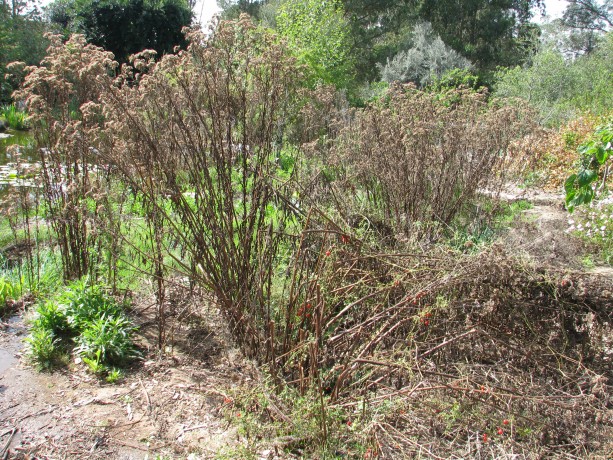
Fleabane stalks from last year, with new growth coming from the roots. Marsh fleabane is an incredible lure for hundreds of our tiny native pollinators and other beneficial insects. Lots of lacewing eggs were on it, too. The plants were coming up from the base, so we cut and dropped these dead plants to mulch the guild.
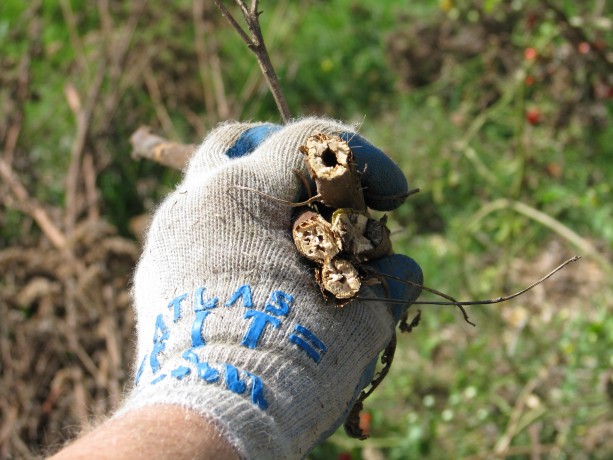
The stalks of fleabane are hollow… perfect homes for small bees! The stems were hollow and just the right size to house beneficial bees such as mason bees. This plant is certainly a boon for our first line of defense, our native insects.
We also chopped and dropped the tomato vines. Tomatoes like growing in the same place every year. With excellent soil biology – something we are still working on achieving with compost and compost teas – you don’t have to rotate any crops.

Slashed and dropped tomato and fleabane. We had also discovered in the last flood that extra water through this heavy clay area would flow down the pathway to the pond, often channeled there via gopher tunnels.
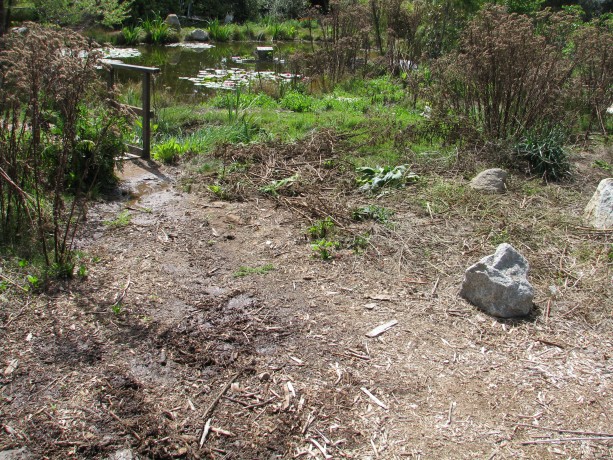
The pathway is a water channel during heavy rains. It needs fixing. We decided to harvest that water and add water harvesting pathways to the garden at the same time. We dug a swale across the pathway, perpendicular to the flow of water, and continued the swale into the garden to a small hugel bed.

Swale dug on contour through the pathway and across the guild. Hugelkultur means soil on wood, and is an excellent way to store water in the ground, add nutrients, be rid of extra woody material and sequester carbon in the soil. We wanted the bottom of the swale to be level so that water caught on the pathway would slowly travel into the bed and passively be absorbed into the surrounding soil. We used our wonderful bunyip (water level).
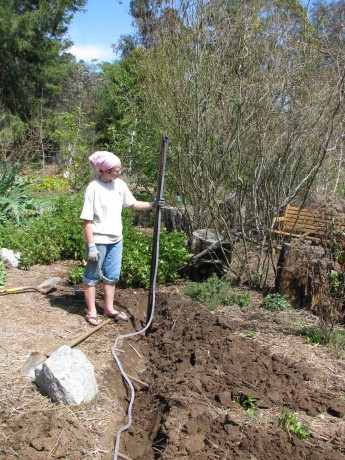
Using a bunyip to make the bottom of the swale level. Water running into the path will now be channeled through the guild. Because of the heavy clay involved we decided to fill the swale with woody material, making it a long hugel bed. Water will enter the swale in the pathway, and will still channel water but will also percolate down to prevent overflow. We needed to capture a lot of water, but didn’t want a deep swale across our pathway. By making it a hugel bed with a slight concave surface it will capture water and percolate down quickly, running along the even bottom of the swale into the garden bed, without there being a trippable hole for visitors to have to navigate. So we filled the swale with stuff. Large wood is best for hugels because they hold more water and take more time to decompose, but we have little of that here. We had some very old firewood that had been sitting on soil. The life underneath wood is wonderful; isn’t this proof of how compost works?
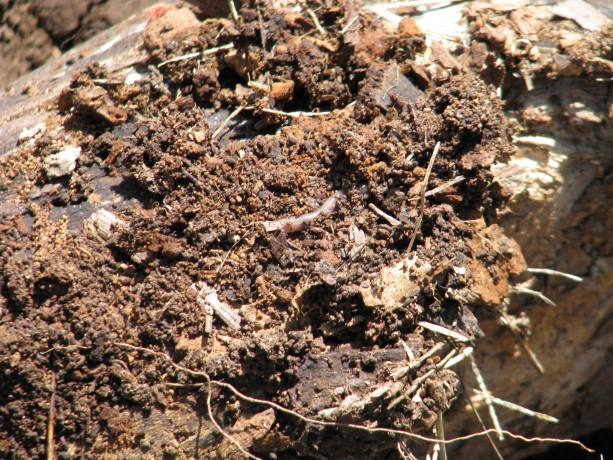
The activity under an old log shows so many visible decomposers, and there are thousands that we don’t see. We laid the wood into the trench.
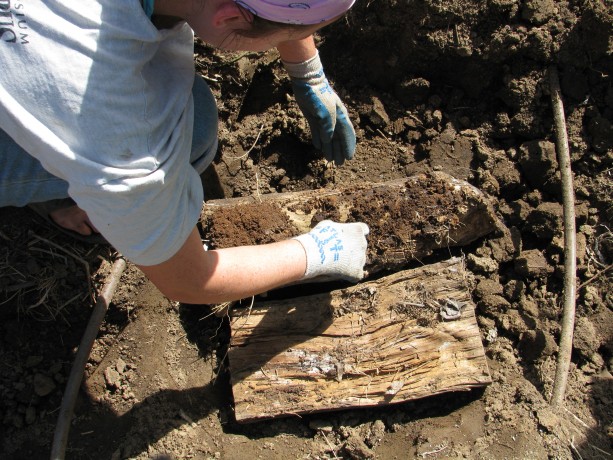
Placing old logs in the swale. If you don’t have old logs, what do you use? Everything else!
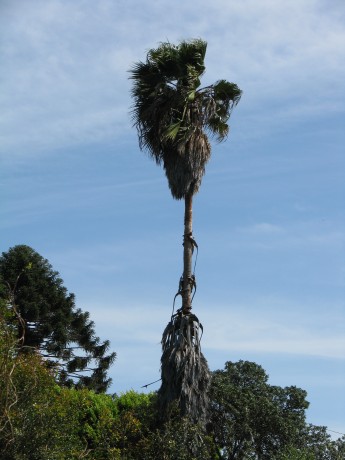
This giant palm has been a home to raccoons and orioles, and a perch for countless other birds. The last big wind storm distributed the fronds everywhere. We are wealthy in palm fronds.
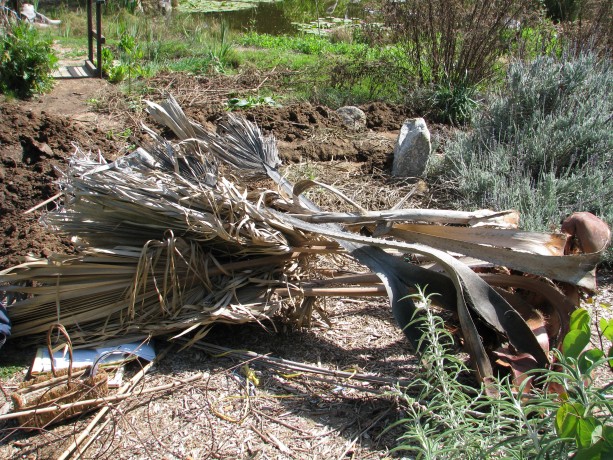
Three quick cuts (to fit the bed) made these thorny fronds perfect hugelbed components. We layered all sorts of cuttings with the clay soil, and watered it in, making sure the water flowed across the level swale.
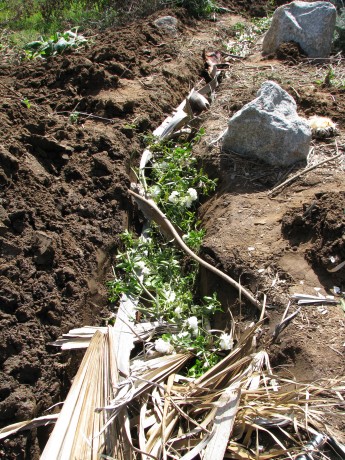
We filled the swale with fronds, rose and sage trimmings, some old firewood and sticks, and clay. As we worked, we felt as if we were being watched.
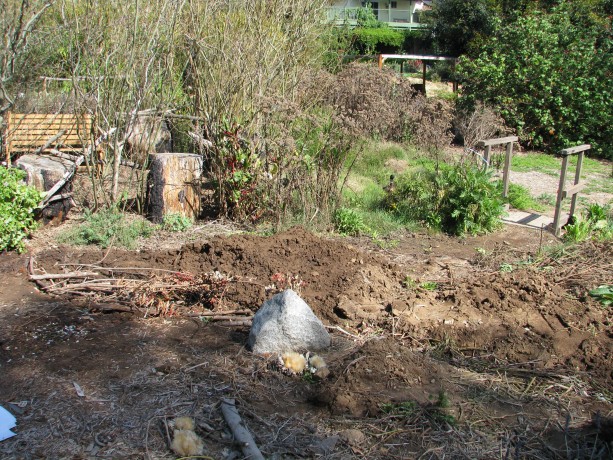
Can you spot the duck in this photo? Mr. and Mrs. Mallard were out for a graze, boldly checking out our progress. He is guarding her as she hikes around the property, leading him on a merry chase every afternoon. You can see Mr. Mallard to the left of the little bridge.
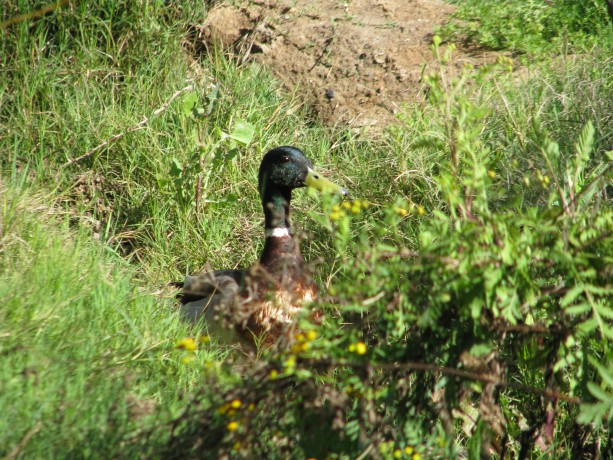
This male mallard and his mate, who is ‘ducked’ down in front of him, enjoyed grazing on weeds and watching we silly humans work so hard. After filling the swale, we covered the new trail that now transects the guild with cardboard to repress weeds.
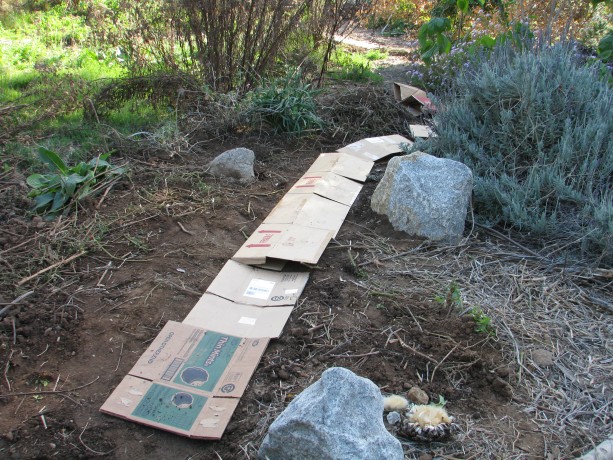
Cardboard laid over the hugelswale. Then we covered that with wood chips and delineated the pathway with sticks; visitors never seem to see the pathways and are always stepping into the guilds. Grrr!

The cardboard was covered with wood chips and the pathway delineated with sticks. Where the trail curves to the left is a small raised hugelbed to help hold back water. At this point the day – and we – were done, but a couple of days later we planted. Polyculture is the best answer to pest problems and more nutritional food. We chose different mixes of seeds for each of the quadrants, based on situation, neighbor plants, companion planting and shade. We kept in mind the ‘recipe’ for plant guilds, choosing a nitrogen-fixer, a deep tap-rooted plant, a shade plant, an insect attractor, and a trellis plant. So, for one quarter we mixed together seeds of carrot, radish, corn, a bush squash, leaf parsley and a wildflower. Another had eggplant, a short-vined melon (we’ll be building trellises for most of our larger vining plants), basil, Swiss chard, garlic, poppies, and fava beans. In the raised hugelbed I planted peas, carrots, and flower seeds.
In the back quadrant next to the mulberry I wanted to trellis tomatoes.
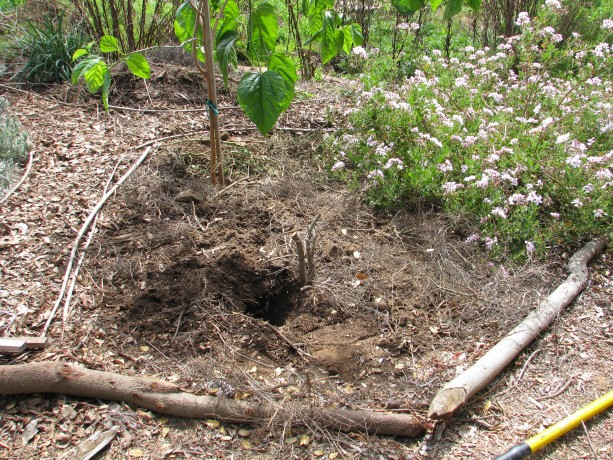
This quadrant by the mulberry needed a trellis for tomatoes. I’d coppiced some young volunteer oaks, using the trunks for mushroom inoculation, and kept the tops because they branched out and I thought maybe they’d come in handy. Sure enough, we decided to try one for a tomato trellis. Tomatoes love to vine up other plants. Some of ours made it about ten feet in the air, which made them hard to pick but gave us a lesson in vines and were amusing to regard. So we dug a hole and stuck in one of these cuttings, then hammered in stakes on either side and tied the whole thing up.
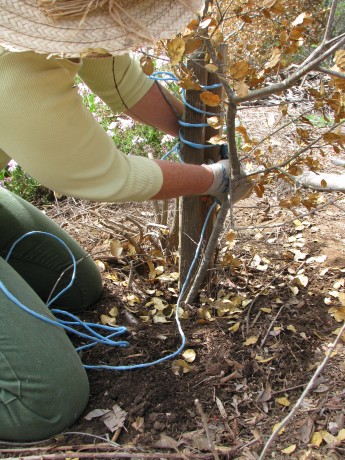
Tying the trunk to two stakes with twine taken from straw bales. Love the blue color! The result looks like a dead tree. However, the leaves will drop, providing good mulch, the tiny current tomatoes which we seeded around the trunk will enjoy the support of all the small twigs and branches, and will cascade down from the arched side.
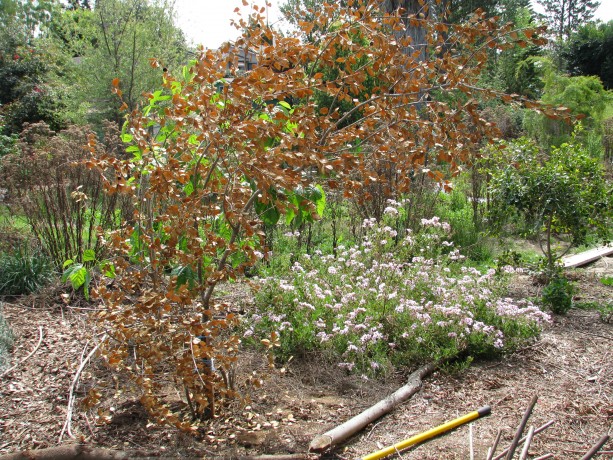
The ‘dead tree’ look won’t last long as the tomatoes climb over it and dangle close to the path for easy harvesting. We seeded the area with another kind of carrots (carrots love tomatoes!) and basil, and planted Tall Telephone beans around the mulberry trunk to use and protect it with vines. We watered it all in with well water, and can’t wait to see what pops up! We have so many new varieties from Baker Creek Heirloom Seeds and other sources that we’re planting this year! Today we move onto the next bed.
- Beverages, Breakfast, Fruit, Permaculture and Edible Forest Gardening Adventures, Recipes, Vegetarian
The Passion of the Fruit: Homemade Juices
Hi there. It’s Miranda the Guestblogger again, and today I want to talk to you about juice. You know, The Big Drip – Drosophilid Milk, Agua Fresca, Drupe’s Tears, Essence of Mesocarp: JUICE.
Here at Finch Frolic Garden, we like a nice fresh juice. As I am officially the FFG Harvester (a.k.a. Fruit Maven), I also take on the mantle of One Who Figures Out What To Do With Some Of The Stuff That’s Been Harvested – and let me tell you, that’s not a title to take lightly.
In the summer, it’s hard to keep up with all the produce and we hate to waste anything, even though spoilt food just goes back into the soil via compost here. We really like to get our produce into our mouths, though. Therefore, a lot of our fruit bounty gets juiced and frozen to keep. I want to walk you through some of our juiceplorations.
Finch Frolic Redoubtable Fruit of Almost Every Month in the Year: the Purple Passionfruit. These exotic and fragrant fruits are dropped by the bushel-load from our vigorous vines almost continuously, but overwhelmingly in midsummer. I pick them off the ground under the vines and wait for their smooth purple shells to wrinkle over in ripeness. Then the process begins.
I sit down for this and usually bring up a show on my laptop, because it takes a while. I have the bag or bowl of fruit on my right and a plastic bag looped over the back of a chair on the other side for the empty shells.
A fruit is picked up, dipped in a bowl of water, then wiped quickly on a paper towel and deposited on a cutting board that has a little rim on it to catch juice.
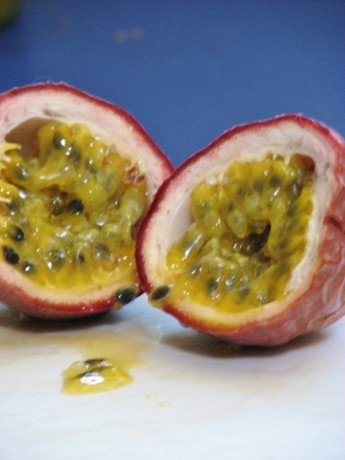
With a sharp knife, I halve the fruits and use a spoon to scoop the many little packets of bright gold-orange juice and hard black seeds into a bowl. Those packets have to be broken to get the juice.
I used to press the pulp into the mesh of a sieve with a spoon, but that’s hard on the hands and on the sieve. Now, I throw it in our Vita-Mix and turn it up to 3, tops – you want to spin all the juice off the seeds, but you don’t want to chop up the seeds. I judge whirl completeness by whether or not the little black seeds are free-floating as they sit in the mixture.
Then I run it through a sieve to separate out the juice.
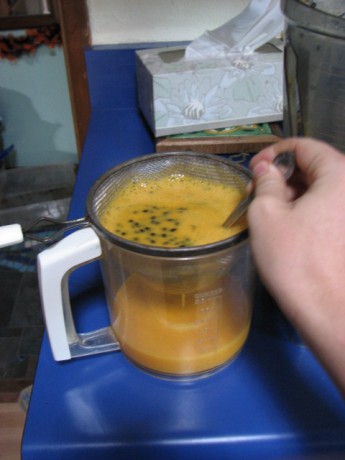
To get the most juice out of it, you swirl a spoon through the pulp as it sits in the sieve. 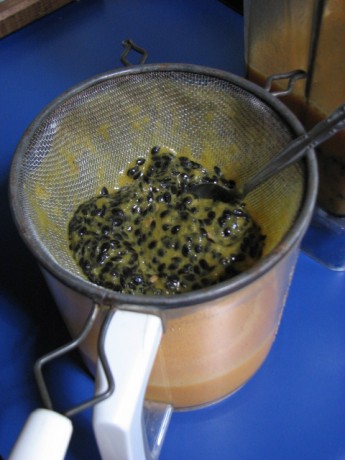
All juiced out. This sounds very labour-intensive – and it is – but it’s worth it to us to use our fruit. We don’t eat passionfruit straight – the seeds are a little too gross. We do, however, use the juice in anything we can make an excuse to, and it keeps frozen into cubes for a long time. And the leftover seeds make a fun treat for our hens.
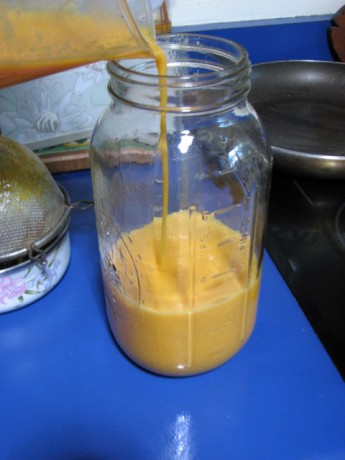
Glowing, beautiful, tangy, fresh passionfruit juice! In the fall, we’re overwhelmed with lovely big pomegranates from our one big pomegranate tree. This year, we’ve had more than ever and we didn’t want to waste any.
Once harvested, though, the poms need to be processed. Diane and I camped out every evening for a couple weeks cutting poms in half and hand-picking the arils. Recently, after a friend let us try out her juicer, we acquired one for ourselves, eliminating the need for the rest of the process with poms, but it is the same process I still use for grapes, apples and melons, so I’m going to tell you about it anyway.
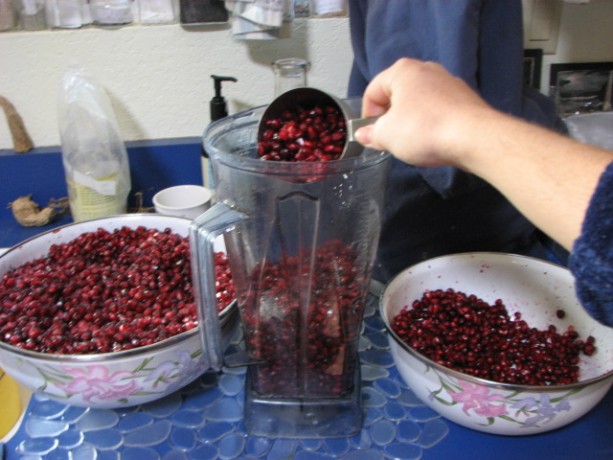
I put the arils in the Vita-Mix and turn all the way up to completely blend the seeds. The blended pom also gets strained, but because the particles are finer than the passionfruit pulp, a mesh sieve isn’t sufficient. No, what you need is a sock.
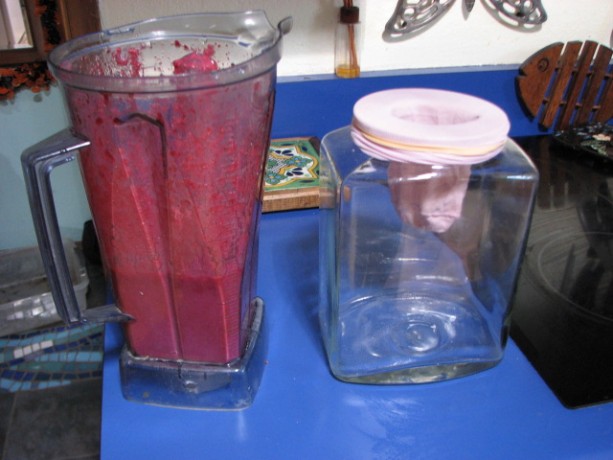
A nice clean women’s nylon sock is perfect. 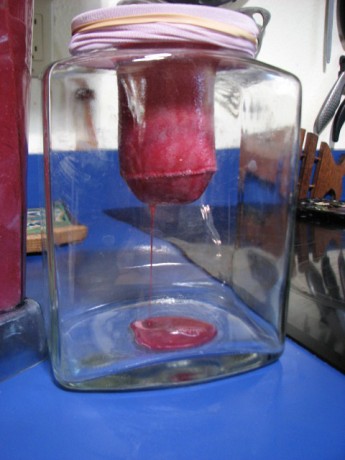
Hanging allows pure juice to come through. To get all the juice out, though, squeezing is necessary, and that puts a little more must in the juice, like fine fruit silt.
It’s also very taxing on the hands, because the sock must be hand squeezed, but it helps get the most juice from the fruit. This second straining produces interesting dry, crumbly must that comes out of the sock like purple Play-Doh.
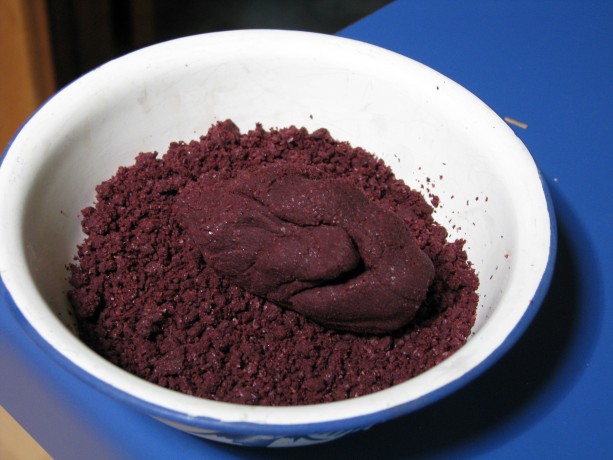
Also a salutiferous treat for the hens! Like the passionfruit, we use the pom juice as much as we can. For instance, we reduced the juice and I experimented with some pomegranate ice-creams:

Chocolate makes an excellent palate cleanser, if you ask us. I also diluted the concentrate with water to make a lovely breakfast juice. We even poached pears with the juice for Christmas dinner – a lovely rose colour and delicate fruity flavor.
The fun never ends with fruit!
So, that’s a little peek at the juiceinations that go on here at Finch Frolic. Happy juicing to you!
TTFN!
Miranda the Fruit Maven
- Animals, Chickens, Cob, Compost, Composting toilet, Fruit, Gardening adventures, Giving, Grains, Health, Herbs, Houses, Hugelkultur, Humor, Living structures, Natives, Natural cleaners, Permaculture and Edible Forest Gardening Adventures, Ponds, Rain Catching, Recipes, Seeds, Soil, Vegan, Vegetables, Vegetarian, Worms
San Diego Permaculture Convergence, Nov. 9 – 10, 2013
There is a fantastic, information-packed permaculture convergence coming up at the beautiful Sky Mountain Institute in Escondido.
 It will be two days packed with great information for a very reasonable price; in fact, scholarships are available. Check out the website at convergence@sdpermies.com. On that Sunday I’ll be teaching a workshop about why its so important to plant native plants, how to plant them in guilds using fishscale swales and mini-hugelkulturs. Come to the convergence and be inspired!
It will be two days packed with great information for a very reasonable price; in fact, scholarships are available. Check out the website at convergence@sdpermies.com. On that Sunday I’ll be teaching a workshop about why its so important to plant native plants, how to plant them in guilds using fishscale swales and mini-hugelkulturs. Come to the convergence and be inspired! -
Plum Clafoutis!

Plum clafouti. Yum. OMG! How could I not have told you about clafoutis yet? If you have ripe plums, peaches, apricots… any stonefruit… and you need something to do with them, this is it! Clafoutis (clow-FOO-tee) is a baked dessert (or breakfast!) that is simple to make and absolutely yummy. Ripe fruit, especially those that are a little too ripe to eat fresh because of the texture, is topped with a flour and custard batter and baked.

Serve plum clafouti warm or at room temperature. So yum. The result is firm enough to not gross out those who don’t like the texture of custard (like my daughter), not too sweet, and makes the flavor of the fruit bloom in your mouth. This is different than Plummy Skillet Cake, which is also wonderful. Of course clafoutis

Because of its simple ingredients and low sugar, clafouti is wonderful for breakfast. Peach clafouti is shown here along with asparagus and soy sausage. is good with ice cream, but just powdered sugar on top for decoration or plain is fine. You can make it with liquid egg substitute and non-dairy milk substitutes; I used our hen’s eggs and organic soy milk. Plums are absolutely delicious in a clafoutis, but we’ve used peaches and apricots as well with great results.
Plum ClafoutisAuthor: Diane KennedyRecipe type: Dessert or BreakfastCuisine: FrenchPrep time:Cook time:Total time:Serves: 6A simple and delicious baked fruit dessert.Ingredients- (You can halve the ingredients and bake in a square pan instead)
- ¼ cup butter (or veg oil or coconut butter)
- Pitted plums cut into thin wedges (think what size you like to bite into) (five cups)(you can use a mixture of stonefruit, too)
- ½ cup granulated sugar, divided (you can eliminate or reduce this amount if you like a tart dessert, if your fruit is very sweet, or use a sugar substitute)
- 4 eggs or equivalent liquid egg substitute
- ½ cup unbleached all-purpose flour (or a mix of other flours)
- ½ teaspoon salt (opt)
- 1 cup milk or milk substitute
- 1 tablespoon vanilla extract
- ½ teaspoon almond extract
- Confectioner's sugar for dusting
Instructions- Move oven rack to the middle and heat to 400F.
- Place butter in a 9 x 13 inch baking dish and put in oven to melt butter.
- In a medium bowl, toss the plums with ¼ cup sugar.
- With oven mitts, remove hot dish from oven and swirl melted butter to coat bottom and partially up the sides.
- Spread plums evenly on bottom of baking dish.
- In a medium bowl, whisk the eggs until blended.
- In a separate bowl, whisk the remaining ¼ cup sugar with the flour and salt.
- Whisk the sugar and flour mixture into the eggs.
- Whisk in the milk, vanilla and almond extracts.
- Pour the batter evenly over the plums.
- Bake 40 - 45 minutes until the clafoutis is lightly browned and the center has puffed up.
- Cool on a wire rack.
- Dust with confectioner's sugar and serve warm, plain or with ice cream. Or hard sauce. Or whatever you like. Use a French accent when announcing dessert.
- Eat within a couple of days or it becomes soggy.
- Store covered at room temperature.
-
Melon Pie!?!

Melon. Pie. Nom. It is melon time in the garden. Fresh green melons served with a little lime juice, or fresh orange melons served with a little lemon juice, are just heaven. When you have too many melons, it is time to look for things to do with them.
Last year we froze melon slices in a mild sugar syrup. This worked well when using the melons in something; the texture was too goopy for eating fresh with any pleasure.
This year I found a recipe in my Baker Creek Heirloom Seed catalog for melon pie. Melon pie? I did a little Googling on the subject and found a lot of melon pie, cake and bread recipes. Who knew? Well, not me anyway.
This recipe works for any melon, the more fragrant the better. It was written for Mother Mary’s Pie Melon, an heirloom that we grew this year. It is small and fragrant, and just makes the right amount of melon the recipe. The version of the recipe in the catalog – which is also in their book The Baker Creek Vegan Cookbook – is vegan. I’ve changed it to vegetarian and you can do what you want with it. The cookie-like crust paired with the creamy yet firm filling is wonderful. Top it with a little whipped cream! They suggest topping with toasted coconut, but I’m not that much of a coconut fan. However I could really see this topped with merangue, like a lemon merangue pie. Yep.
Melon PieAuthor: Originally from Baker Creek Vegan CookbookRecipe type: DessertCuisine: AmericanPrep time:Cook time:Total time:Serves: 8A fragrant, yummy pie with a perfumy melon flavor and crisp cookie crust.Ingredients- Crust:
- ½ cup butter or vegan alternative
- ¼ cup packed brown sugar (or white)
- 1¼ cups unbleached flour (organic if possible)
- Filling:
- ½ cup sugar
- 3 Tablespoons cornstarch (organic if possible)
- 1 egg, beaten
- 1½ cups cubed melon, liquified in blender (makes 1½ cups)
- ¼ cup water
- 3 Tablespoons butter or vegan alternative
- 1 teaspoon fresh squeezed lemon juice
Instructions- Prepare crust: beat butter and sugar in mixer until fluffy.
- Add flour and mix thoroughly.
- Press into bottom and sides of a 9" pie pan.
- Bake crust at 375F for 10 - 12 minutes until lightly browned.
- Meanwhile, stir sugar and cornstarch together in medium saucepan and set aside.
- Blend egg, melon and water together until smooth.
- Over medium heat, gradually stir melon mixture into cornstarch mixture, stirring constantly until mixture thickens and begins to boil, about ten minutes. Don't rush!
- Reduce heat and cook 1 minute more.
- Remove from heat and stir in 3 T butter and lemon juice.
- Pour into pie shell, cool and then refrigerate at least an hour before serving.
- Serve with whipped cream... or not.

